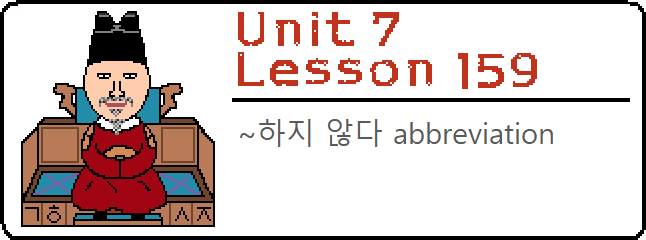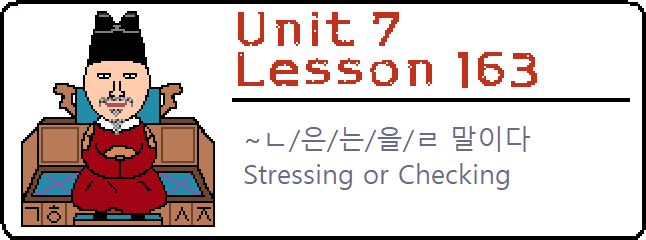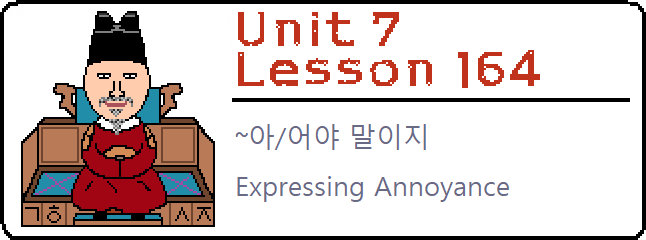 Lesson 159: In this lesson, you will learn about an abbreviation of ~하지 않다: ~치 않다 and ~지 않다. You will see how your choice of abbreviation is dependent on the final letter before ~하. Lesson 159: In this lesson, you will learn about an abbreviation of ~하지 않다: ~치 않다 and ~지 않다. You will see how your choice of abbreviation is dependent on the final letter before ~하. |
 Lesson 160: In this lesson, you will learn how to use a familiar grammatical principle, ~느냐 to create a more complex meaning than what you already have learned. Furthermore, you will learn to add ot ~느냐 to make it even more complex. Lesson 160: In this lesson, you will learn how to use a familiar grammatical principle, ~느냐 to create a more complex meaning than what you already have learned. Furthermore, you will learn to add ot ~느냐 to make it even more complex. |
 Lesson 161: In this lesson, you will learn how to describe upcoming nouns with ~느냐, which you learned in the previous lesson Lesson 161: In this lesson, you will learn how to describe upcoming nouns with ~느냐, which you learned in the previous lesson |
 Lesson 162: In this lesson, you will learn how to add another layer of complexity to sentences with ~느냐. By using the verb 따르다 in sentences with ~느냐, you can create the meaning of “depending on…” in English. Lesson 162: In this lesson, you will learn how to add another layer of complexity to sentences with ~느냐. By using the verb 따르다 in sentences with ~느냐, you can create the meaning of “depending on…” in English. |
 Lesson 163: In this lesson, you will learn how you can end your sentences colloquially with 말. We’ll break down the situations where this would be appropriate and natural. Lesson 163: In this lesson, you will learn how you can end your sentences colloquially with 말. We’ll break down the situations where this would be appropriate and natural. |
 Lesson 164: In this lesson, you will continue to see how versatile the noun 말 can be. Specifically we will see how using 말 at the end of a sentence, but preceded by something different than the previous lesson, you can create an entirely different meaning. Lesson 164: In this lesson, you will continue to see how versatile the noun 말 can be. Specifically we will see how using 말 at the end of a sentence, but preceded by something different than the previous lesson, you can create an entirely different meaning. |
 Lesson 165: In this lesson, you will see another way that 말 can be used, this time, by having it follow ~(으)니 or ~기에. Here, you will see how it can be used to emphasize fortune or releif. Lesson 165: In this lesson, you will see another way that 말 can be used, this time, by having it follow ~(으)니 or ~기에. Here, you will see how it can be used to emphasize fortune or releif. |

Lesson 166: In this lesson, we will see the nuanced meaning that ~(이)야말로 can add to a sentence. Specifically, you can use this to emphasize one specific noun or situation over all others. |
 Lessons 159 – 166 Mini-Test: Test yourself on what you learned from Lessons 151 to 158! A Mini-Test like this will be uploaded after every eight lessons. Don’t worry if the test doesn’t go so well – this website is here to help you! Lessons 159 – 166 Mini-Test: Test yourself on what you learned from Lessons 151 to 158! A Mini-Test like this will be uploaded after every eight lessons. Don’t worry if the test doesn’t go so well – this website is here to help you! |
All finished with Lessons 159 – 166? Click here to check out the next eight lessons.

